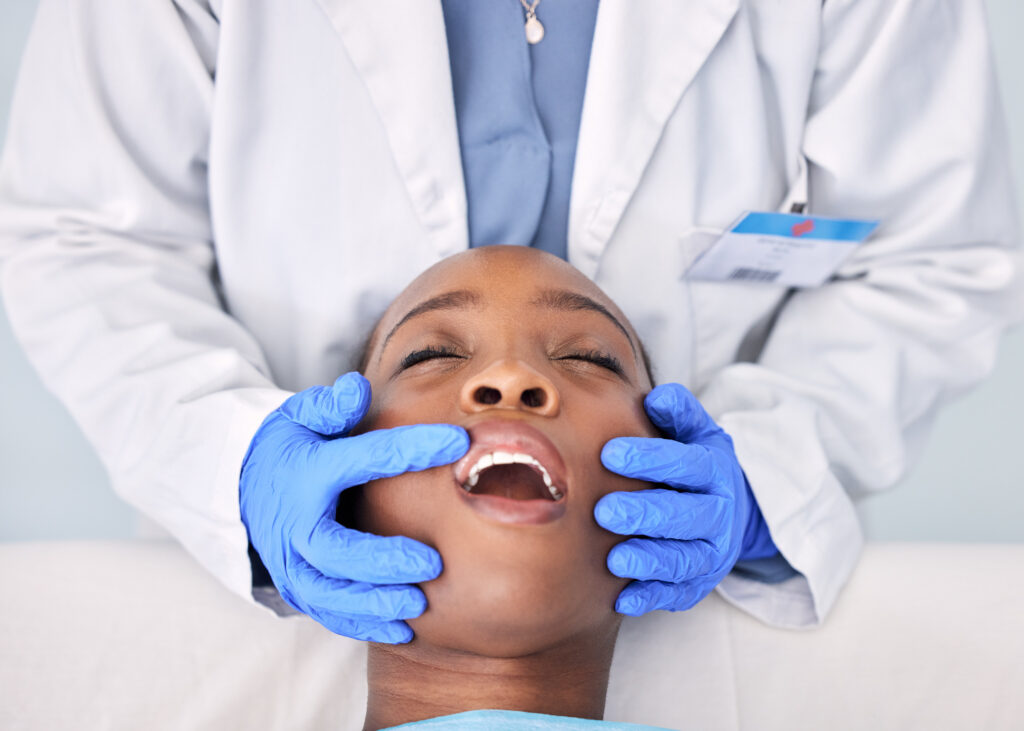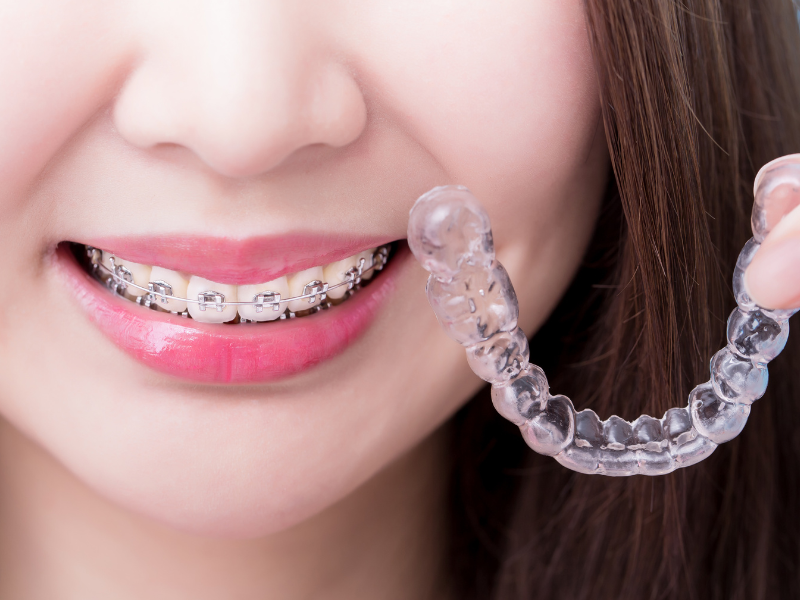
Publication date: November 11, 2025
Bruxism is the involuntary movement and spasms of the masticatory muscles, which cause teeth grinding. Most often, this occurs during sleep, but it can also happen while awake. Such a problem can lead to other unpleasant consequences, as it puts strain on the temporomandibular joint.
Daytime vs. Sleep Bruxism – What’s the Difference?
Bruxism cannot be round-the-clock. It is divided into two types – daytime and nighttime, and it is quite easy to determine which one you have by understanding their differences.
| Daytime | Sleep Bruxism |
| Appears when a person is awake. | Appears during sleep. |
| It often occurs due to stress, excessive anxiety, fatigue, and malocclusion. | It may be unconscious, so the risks of complications due to the inability to control symptoms are higher. |
Regardless of the type of bruxism, it must be taken into account. A competent approach will help you eliminate unpleasant symptoms and return to your previous, full life.
Why It Happens: Root Causes & Risk Factors
The disease can occur due to several factors. The most common is stress, so if it prevails, try to reduce it. It provokes many unpleasant symptoms, such as dental ones.
If bruxism appears in a child, check whether they have any conflicts with their peers or other psychological problems. If they do not show any emotions during the day, teeth grinding during sleep may signal that they are releasing internal tension at this time.
Stress & Anxiety, Sleep Disorders, Medications, Bite
Psychological problems can occur in anyone, and in such cases, the body may succumb to involuntary spasms in the teeth. Here are the main causes of this condition:
- stress, various types of emotional experiences;
- unhappiness, problems in personal life, at work, or at school;
- insecurities, low self-esteem;
- feelings of guilt;
- sleep disorder;
- certain medications (e.g., anti-anxiety drugs);
- a huge responsibility that causes anxiety.
Dysfunction of the temporomandibular joint can also contribute to this problem. However, it may also be related to other dental problems, including incorrect bite, crowding, and tooth loss. If your relatives have had similar problems, consider your genetic predisposition.
Studies have shown a correlation between apnea and teeth grinding. This is a condition in which breathing resumes during sleep. In this case, the jaw moves to breathe again through the blocked airways. If these problems are not treated in time, headaches and worsening dental conditions may develop.
Lifestyle Triggers
To avoid feeling pain, you need to rethink your lifestyle. People who drink alcohol and smoke are at greater risk of developing bruxism. If you drink more than 6 cups of coffee a day, this can also cause damage to your teeth.
The fast pace of modern life can cause stress. To reduce its likelihood, learn how to deal with stress effectively. Therapy, relaxation techniques, and other hobbies that distract you from everyday tasks can help.
How to Treat Bruxism: A Step-by-step Care Path
When it comes to treatment, the most important thing is to trust a professional. Bruxism teeth repair is not such a complicated process if you follow the right plan and adhere to all of your doctor’s recommendations. Start with a consultation, which will help you get an accurate diagnosis and begin treatment sooner.
Habit Awareness & Daytime Relaxation Techniques
There are many behavioral therapy methods for bruxism, allowing everyone to choose the option that works best for them. It could be:
- Cognitive behavioral therapy. Its essence lies in changing the type of thinking, allowing you to get rid of destructive attitudes. Therapy takes the form of dialogue, without focusing on the past, but only taking into account current problems.
- Yoga and meditation. Many people use these methods to combat stress. These practices can be done at home or in group classes. Also, when the weather is nice, consider outdoor exercises.
- Physical exercise. Continue to take care of yourself and your body. Practice facial exercises, celestial exercises, and massage.
- Proper rest. Stress often arises from having too many tasks, so you need to know how to recharge. Quality sleep, walking, and monitoring your well-being should be a priority.
Plan your day with the right habits. This will help you avoid problems and keep your enamel healthy and a beautiful smile.
Nighttime Protection
It is not advisable to self-medicate, so if you want to protect yourself, consult your doctor first. They may recommend additional home treatments. If loved ones are nearby, they can help by massaging your back and neck before bedtime. After that, you can spend some time meditating and drinking soothing teas. Special warm compresses are used to relieve tension in the jaw, but these methods do not guarantee results.
To protect teeth from wear and tear and the need for further restoration, the dentist may give you a night guard. It is made to custom order by taking an impression of the oral cavity. It provides cushioning and shock absorption, thereby reducing stress on the jaw and even helping to straighten teeth. They are usually made of flexible plastic or silicone and are easy to put on and take off.
Managing Contributing Factors
As you can see, there are many ways to treat bruxism in adults. This may involve a comprehensive approach that includes dental treatment, psychotherapy, medication, and physical exercise. Patients need to change their lifestyle to avoid the recurrence of such conditions.
Avoid stress as much as possible or learn to channel it in the right direction. Instead of smoking and drinking alcohol, take up a sport or go for walks in the park. Not only is this good for your health, but it can also give you new ideas.

Dental Interventions
The first step in combating bruxism is to visit the dentist. The dentist will begin by taking your medical history and examining your mouth. If they need to study the patient’s body in more detail, they may also refer them for polysomnography (a sleep study). He will advise you on the stages you need to take to get rid of the discomfort.
The treatment plan is always different for each patient. The dentist may prescribe mild sedatives and sleeping pills, magnesium and calcium, or vitamin B.
If a patient has problems with their dentoalveolar system, they may need:
- braces;
- prosthetics;
- splinting;
- replacement of fillings;
- implants that restore the dental arch.
Once you have eliminated bruxism, do not forget about prevention. Visit your dentist regularly (at least twice a year) and do not put off treatment until later. This will allow you to always be aware of the condition of your teeth, avoiding misaligned teeth and other unpleasant symptoms.
Repairing Damage From Bruxism
A chipped, cracked, or worn tooth is not only an aesthetic problem, but also a comfort issue. If you delay treatment for bruxism, it can lead to hypertonicity of the jaw muscles, overbite, and other problems.
Remedies for the effects of bruxism depend on the degree of damage to the teeth. The main types of restoration include:
- Dental crowns. They completely cover damaged teeth. Crowns are recommended if there is extensive damage to the front of the teeth, the enamel is worn away, or the anatomical shape of the tooth needs to be restored. Their advantage is the functionality of their chewing teeth, making them as comfortable as possible when eating.
- Composite connection. This is the restoration of teeth using special filling materials. It is more often chosen for minor damage, as it allows you to remove chips and unevenness and ensure the perfect shape of the teeth. The advantage is that there is no need to grind down healthy surfaces, and the affordable price.
- Porcelain veneers. They look natural (but it depends on the shade you choose), so they are used to restore an aesthetic smile. They are custom-made for each patient in a laboratory. Veneers correct cracks, chips, and shortened teeth. To install them, a thin layer of tooth enamel must be removed. The main advantages are even color, a perfect smile, and durability.
There is no universal restoration option for all cases, so it is important to listen to your dentist.
How to Stop Bruxism at Night – Putting It All Together
To combat bruxism, consult a qualified dentist. Take care of yourself by reducing stress levels and minimizing harmful habits. Try to go to bed at the same time every night and relax before going to sleep. For example, you can do breathing exercises. Once the bruxism has gone away, continue to monitor your health and teeth by visiting the dentist every six months.







